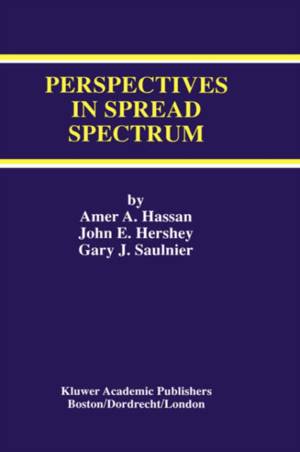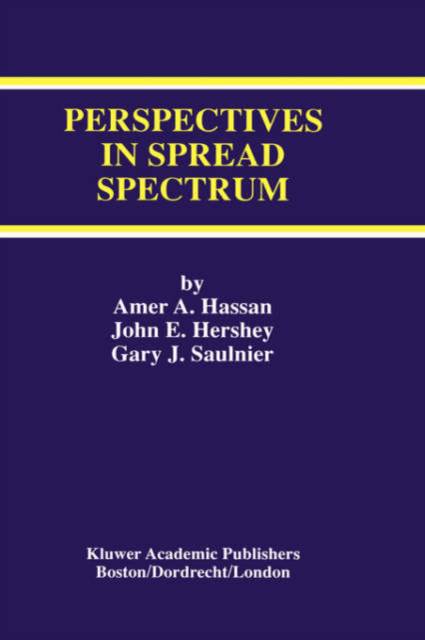
- Retrait gratuit dans votre magasin Club
- 7.000.000 titres dans notre catalogue
- Payer en toute sécurité
- Toujours un magasin près de chez vous
- Retrait gratuit dans votre magasin Club
- 7.000.000 titres dans notre catalogue
- Payer en toute sécurité
- Toujours un magasin près de chez vous
182,45 €
+ 364 points
Description
Perspectives in Spread Spectrum brings together studies and recent work on six exciting topics from the spread spectrum arts. The book gives a wide, collective view of trends, ideas, and techniques in the spread spectrum discipline, due to the authors' extensive work on spread spectrum techniques and applications from different vantage points. The inexorable march of electronics towards ever faster, ever smaller, and ever more powerful electronic and optical circuitry has wrought, and will continue to enable, profound changes in the spread spectrum arts, by allowing increasingly complex signalling waveforms and statistical tests to be implemented as the theory beyond spread spectrum continues to evolve.
Perspectives in Spread Spectrum is divided into six chapters. The first chapter deals with sequence spreading design. There is not a single metric for design of spreading sequences; rather, the design is ideally tailored to the specific scenario of usage. This chapter delves into recent and very promising synthesis work. The second chapter deals with OFDM techniques. As channels become wider and trans-channel fading (or jamming) becomes frequency selective across the band, OFDM techniques may provide a powerful alternative design perspective. The third chapter is a generalization of the venerable Walsh functions. A new modulation scheme, Geometric Harmonic Modulation, GHM for short, is reviewed and characterized as a form of OFDM. From GHM, a further generalization of the Walsh functions is derived for non-binary signalling. The fourth chapter is concerned with some new and exciting results regarding the follower jammer paradigm. A counter-countermeasure technique is reviewed, notable for its counterintuitive characteristic which can be understood from a simple yet elegant game framework. The fifth chapter recounts some results pertaining to random coding for an optical spread spectrum link. The technique is basedon laser speckle statistics and uses a coherent array of spatial light modulators at the transmitter but allows the receiver to be realized as a spatially distributed radiometric and therefore incoherent structure. The sixth and final chapter looks at an important and interesting application of spread spectrum to accurately locate a wideband, 'bent pipe', satellite transponder. It is, in a strong sense, an inverted GPS technique.
Perspectives in Spread Spectrum serves as an excellent reference and source of ideas for further research, and may be used as a text for advanced courses on the topic.
Perspectives in Spread Spectrum is divided into six chapters. The first chapter deals with sequence spreading design. There is not a single metric for design of spreading sequences; rather, the design is ideally tailored to the specific scenario of usage. This chapter delves into recent and very promising synthesis work. The second chapter deals with OFDM techniques. As channels become wider and trans-channel fading (or jamming) becomes frequency selective across the band, OFDM techniques may provide a powerful alternative design perspective. The third chapter is a generalization of the venerable Walsh functions. A new modulation scheme, Geometric Harmonic Modulation, GHM for short, is reviewed and characterized as a form of OFDM. From GHM, a further generalization of the Walsh functions is derived for non-binary signalling. The fourth chapter is concerned with some new and exciting results regarding the follower jammer paradigm. A counter-countermeasure technique is reviewed, notable for its counterintuitive characteristic which can be understood from a simple yet elegant game framework. The fifth chapter recounts some results pertaining to random coding for an optical spread spectrum link. The technique is basedon laser speckle statistics and uses a coherent array of spatial light modulators at the transmitter but allows the receiver to be realized as a spatially distributed radiometric and therefore incoherent structure. The sixth and final chapter looks at an important and interesting application of spread spectrum to accurately locate a wideband, 'bent pipe', satellite transponder. It is, in a strong sense, an inverted GPS technique.
Perspectives in Spread Spectrum serves as an excellent reference and source of ideas for further research, and may be used as a text for advanced courses on the topic.
Spécifications
Parties prenantes
- Auteur(s) :
- Editeur:
Contenu
- Nombre de pages :
- 163
- Langue:
- Anglais
- Collection :
- Tome:
- n° 459
Caractéristiques
- EAN:
- 9780792382652
- Date de parution :
- 31-08-98
- Format:
- Livre relié
- Format numérique:
- Genaaid
- Dimensions :
- 177 mm x 228 mm
- Poids :
- 421 g







